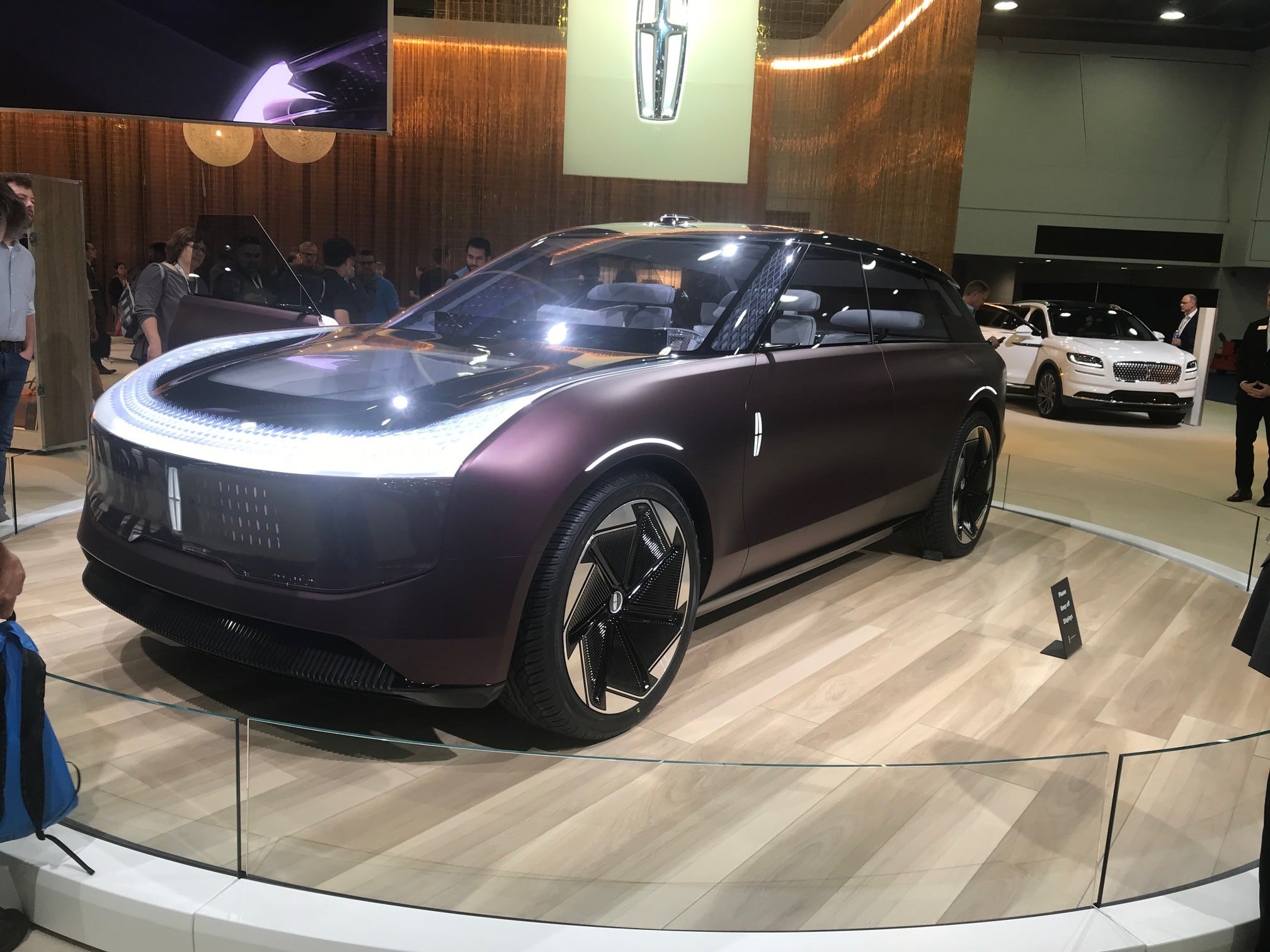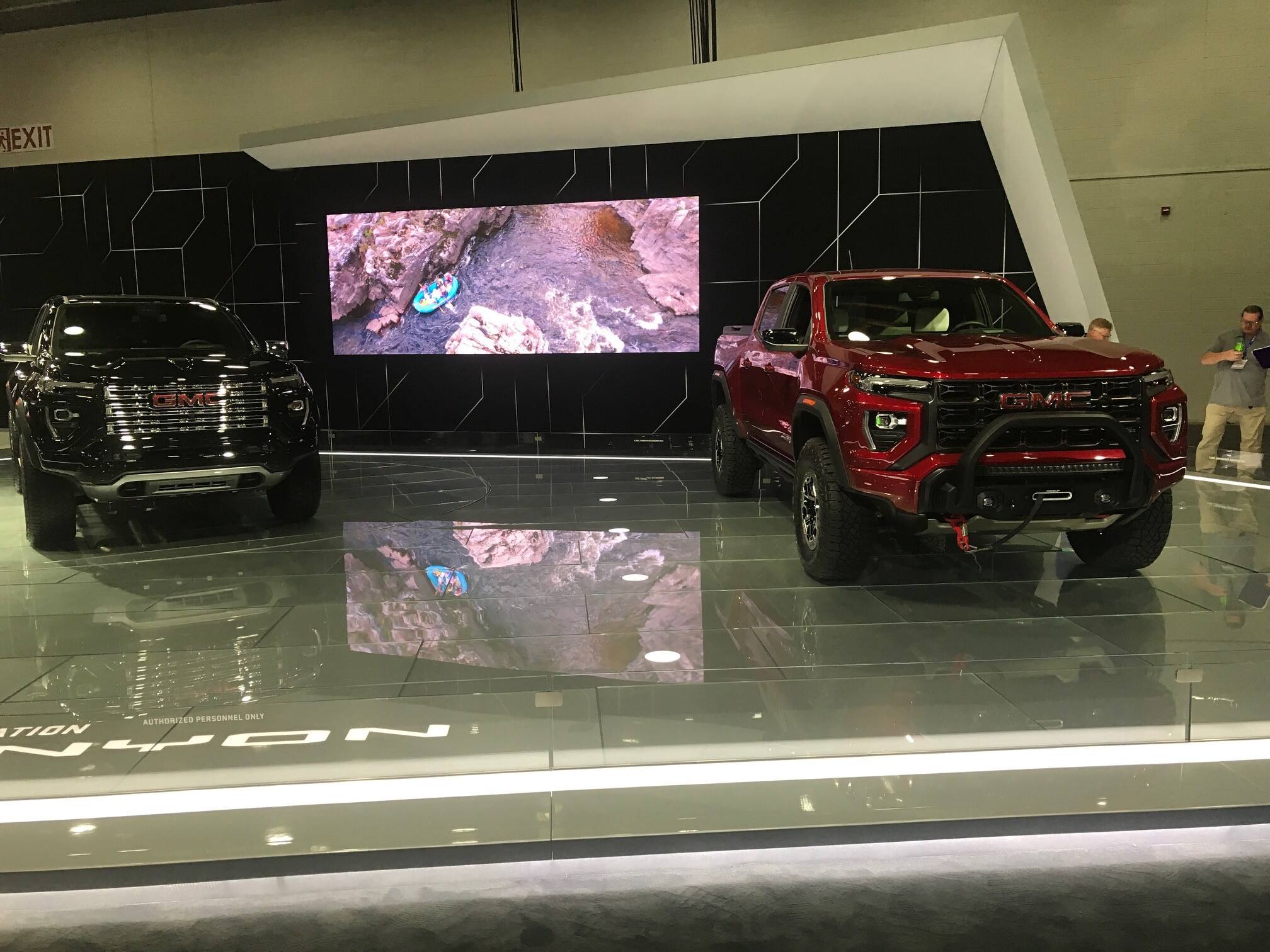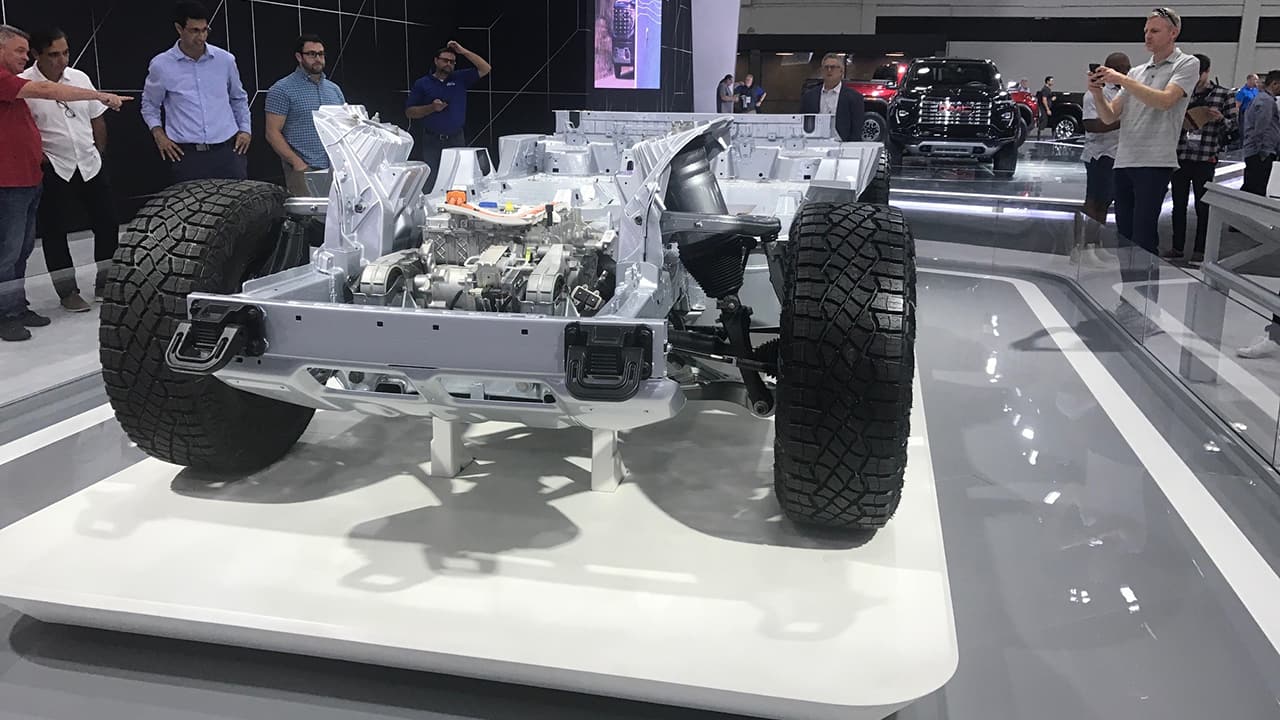Customer Logins
Obtain the data you need to make the most informed decisions by accessing our extensive portfolio of information, analytics, and expertise. Sign in to the product or service center of your choice.
Customer LoginsFuel For Thought: Detroit Auto Show 2022 - An industry in transition
Automotive Monthly Newsletter & Podcast:
Detroit Auto Show 2022: An industry in transition
The reimagined 2022 Detroit Auto Show, also known as the North American International Auto Show, finished its media and industry days with limited automakers and brands participating after a three-year hiatus in the city. Those OEMs and brands who did participate - mostly the hometown automakers - most told a brand story that included both internal combustion engine (ICE) and electric vehicle (EV) solutions. While tomorrow's auto market seems to be rushing to be electric, today is in transition. The result is a more dynamic and diverse market than ever, and this was reflected in the vehicles that were on the show floor this year. The show included trucks, cars, SUVs, and sporty cars, with all kinds of propulsion systems. For automakers, this diversity is needed. ICE vehicles will dominate the market throughout this decade, and those vehicles tend to have higher profit margins, creating revenue required to fund EV development. For consumers, there is an unprecedented level of choice. The increased level of choice could be a double-edged sword. Generally, having more options is good. But there can also be a point where too much choice is overwhelming.
Shows across the globe are under increased pressure to prove return on investment, against an environment where there are many platforms for new car reveals outside of the traditional auto show. OEMs will continue to invest in consumer-facing auto shows and events. They recognize that direct exposure and experience with a vehicle is the best sales tool they have. There is no replacement for butts in seats, regardless of segment or propulsion system, but the traditional auto show is not the only venue to achieve that objective. The trend prior to the pandemic was a shift away from traditional auto shows, and we will continue to see limited participation in the traditional format versus pre-pandemic years, both for media-facing and consumer-facing sides of the show. We can find any number of consumer trends that were evident prior to the pandemic and accelerated through it. Automaker participation in auto shows is just one.
Hometown automakers carry the show
Ford, General Motors and Stellantis each took up residence in large portions of the auto show floor, but in a much different capacity than in years past. Ford Motor Company offered different narratives for each of its two brands. Lincoln had its EV story front and center, with two true concept vehicles in the L100 car and Star Concept utility vehicle, which had been unveiled at previous media events. The brand's official show reveal was a refresh of the compact Corsair utility vehicle, with a minor change to the front and rear and a significant technology upgrade. For the first auto show in Detroit in 44 months, Lincoln focused on exploring the future of the brand in its EV concepts - both of which, Lincoln told us, were developed purely as concept vehicles and opportunities to explore the future of Lincoln and its "Quiet Flight" design and customer experience positioning in an electric or autonomous vehicle. The president of Lincoln, Joy Falotico, said during an interview with S&P Global Mobility that the Star concept in particular is closer to what we will see with Lincoln's first EV. Not only is there technology packed in the vehicle that we will see at launch, but other elements will appear in future vehicles- as soon as technology can deliver it.

Photo by James Martin, S&P Global Mobility
The most important element of the Corsair's update is Lincoln's L2-plus hands-free, eyes-on autonomous driving system called Active Glide 1.2. The "1.2" designates an update to the version which Lincoln launched on the latest Navigator early in second quarter 2022 and which Ford launched on the F-150 Lightning and Mustang Mach-E as BlueCruise. The new system adds turn-signal activated, automated lane changes, and a significant upgrade offered in a short amount of time. Both the speed to market and the launch of the update on Lincoln's entry product are significant. Particularly with software, brands simply cannot wait until the next flagship to roll out updates and improvements. Second, the speed in delivering the update reflects a new urgency within Ford. Rival GM's Super Cruise was first to market, but it was several years in before an automated lane-change feature was added. However, GM's system remains more refined, has some features that Ford does not yet have, and offers a larger network of mapped roads. The race is on for expanding the capabilities of these systems. Though Ford joined later, it does intend to have a strong and competitive presence.
The Ford display reflected its more dynamic lineup, and the company's intent to continue internal combustion engine (ICE) products under Ford Blue and launch EV products under Ford Model E. For this show, Ford's seventh-generation Mustang coupe and convertible was revealed during an outdoor event at Detroit's Hart Plaza.
Though Ford is committed to its EV path, there was no news on that front for this year's show. While these products had a starring role in the show display the massive show stand included a ride-along experience: Acceleration rides in the F-150 Lightning and a Bronco capability crawl over several man-made metal obstacles. The Ford stand featured Bronco and its new variants (Everglades and Raptor), as well as the Bronco Sport. Along with the F-150 Lightning, the F-150 Raptor R was displayed.

Photo by James Martin, S&P Global Mobility
General Motors had several large and impressive exhibit areas at this year's auto show. The primary stand, and the company's highest-volume brand, was Chevrolet. This was also the only display with a new product reveal, the performance edition of the Tahoe RST full-size utility. However, the stand prominently featured both Chevrolet's ICE and EV stories. Not unlike the two Lincoln concepts, Chevrolet had revealed several new products over the course of the summer which were on display. Chevrolet highlighted the Equinox EV, Blazer EV and Silverado EV, as well as the Bolt EV and Bolt EUV. Though the two Bolt products are set to be discontinued to make room for production of EV pick-up trucks at their Orion plant while the other EVs displayed are just starting their product lifecycle, Chevrolet will have a robust EV lineup by the end of 2023. On the ICE side, Chevrolet had an equally impressive section, anchored with the Corvette Z06 and prominently featuring the new-generation Colorado mid-size truck and recently added Silverado ZR2 Bison.
The Buick, Cadillac, and GMC displays also demonstrated a blend of legacy and future-tech stories. Cadillac had no news, though displayed its first EV Lyriq next to the 682-hp V8 Escalade V; the upcoming Celestiq halo EV was not on display, as Cadillac is holding that for exclusive customer interactions.
Buick, however, has little immediate news on either the ICE or EV side, but built on its earlier announcement of moving toward an all-EV lineup by 2030. The Wildcat concept was prominently displayed, on a slightly lifted center dais; the vehicle is more impressive in person than photos suggest. This does not alleviate the curiosity of introducing EV themes on a two-door coupe, a vehicle unlikely to be built or offered in the US.
GMC had the Hummer SUV on display for the first time at an auto show, though it was formally revealed in 2021. The SUV was alongside the Hummer pick-up, which officially went on sale in January 2022. GM is taking an intentionally slow production ramp-up with this first Ultium EV product, laying the groundwork for necessary learning and process improvements which will presumably mean faster production ramp-ups for subsequent products. The GMC brand was also the one to display an Ultium battery cutaway, a property GMC used during various media and other reveals for the Hummer. While Chevrolet has the new-generation Colorado, GMC has a similarly fresh Canyon; the Sierra AT4X off-road edition is the counterpart to the Silverado ZR2 Bison.

Photo by James Martin, S&P Global Mobility

Photo by James Martin, S&P Global Mobility
Stellantis opted to create pre-show buzz with various events in the days and weeks prior, rather than making major news at the show. While Stellantis outlined near-term future Jeep EV products earlier in September, none were on display in Detroit. The Jeep products shown focused on special options packages for the Grand Cherokee and Wrangler 4xe. While these can build on buzz for the 4xe solution and are well executed in Jeep style, these announcements were fairly minor. The show also marked the first time Jeep has had an indoor off-road simulation display, tucked in the back of the exhibit.
For Dodge, a significant amount of show floor space was dedicated to showing off products revealed at other events in Detroit less than a month earlier. Dodge's sponsorship of the Roadkill Nights street drag racing event earlier this summer in Detroit was a better backdrop than any auto show, as the event truly caters to Dodge loyalists and creates stronger in-person and internet buzz.
The Chrysler brand revealed the special edition of the soon-retired 300, though the model was a bit difficult to find on the show stand. Ram did not have any news for the show, though during the week announced the Ram 1500 would drop its diesel option with the end of the 2023 model year.
Toyota and Subaru displays featured previously announced vehicles as well. Toyota focused on the upcoming Crown sedan, recently launched Sequoia and new Tundra - though it did not display its all-new bZ4X EV for consumers. The GR (or Gazoo Racing) family of performance variations of Supra, Corolla and 86 was also on display. Though Toyota did not announce news for the show, it is the fourth best-selling brand in Michigan, behind Ford, Chevrolet and Jeep, and the stand focused on a consumer-friendly space to relax and look at new products. Subaru has been relatively consistent displaying at auto shows, including its tie-in with U.S. national parks, as well as animal shelters with the potential for adopting a puppy straight from the show floor. For Subaru at auto shows, the vehicles almost seem an afterthought, though the company creates an environment that will connect with its buyers.
What's Next?
Despite the limited OEM participation, most displays worked to tell stories about a transition to EVs, alongside new trucks and sporty cars with internal combustion engines under the traditional hood. The event embodied the dynamics of today's auto market and the interplay between needing to support the current demand for ICE products as well as the need for helping consumers along the path of transitioning to the electrification and electric vehicles.
The three companies with headquarters in the Detroit area -- Ford, GM and Stellantis -- dominated the show floor, just as they do regional sales. According to registration data from S&P Global Mobility, Ford, Chevrolet, and Jeep are the top three brands in the Detroit DMA as well as the state of Michigan so far this year. Through July, these three accounted for 56% of Michigan registrations, up from 53% in 2021. Adding in the fourth and fifth-place brands, Toyota and GMC, the top five account for about 77% of light vehicle registrations in Michigan. Importantly, all the brands with significant sales stakes in the region were present, with fresh products and compelling stories.
However, the show was missing presence from several prominent automakers. Some OEMs have decided to sit out the 2022 auto show season entirely, while others are balancing the effectiveness of dollars spent in this market versus other methods for reaching out to Detroit-area consumers. Still, others simply did not have news that aligned with Detroit timing or felt an alternate reveal was better suited to their go-to-market plans. Luxury German brands decided after the 2018 show not to return, and the events since that decision have not changed their approach. Among the volume brands missing in Detroit were Honda, Hyundai, Kia, Mazda, Nissan, and Volkswagen. For these brands, their luxury divisions (Acura, Genesis, Infiniti, Audi) were also not present.
Though the details vary by automaker, these OEM absences in Detroit are a sign of a larger issue. Auto shows have been under pressure to show a reasonable return on an OEM's investment for years. The Detroit show is no different -faced with rebuilding itself after an extremely long hiatus exacerbated by Covid-related cancellations.
Essentially since the 2009 recession, automakers have been putting the expense of auto shows under increasing scrutiny, especially given that there is no shortage of digital and other platforms available, and many are less expensive. During a virtual media roundtable at the show, Stellantis CEO Carlos Tavares said that Stellantis still plans on being in shows, but only if they are cost-effective: "I think everybody now understands that the show is not made for the egos of the top executives of the automotive industry. Everybody is looking at the return on investment in a more business-oriented way. If we are looking for a better return on investment, it makes more sense with a more frugal and more focused way of displaying the products and technology." Much of Tavares' view is shared across the industry.
The use of auto shows as a venue for revealing new vehicles is contracting, and if the Detroit show is any indicator, investment in the consumer side may also be under cost pressure. The brands with automaker support had a strong presence - if less lavish or complex than in some prior years - and brands supported by local dealers had cars displayed with little support from their parent companies. That said, while extravagant stands may be a thing of the past, being too frugal casts a negative light on a brand as well.
As automakers look to balance strained costs related to EV development, questions arise as to the value of splashy new-vehicle introductions. Against the backdrop of increased costs and the opportunity for new media platforms with the potential to create a more direct consumer relationship, this year's Detroit show is just the most recent example of the intensified budgetary pressure these events are under.
---------------------------
Dive Deeper — Check out our automotive
insights
Download videos and presentations from S&P Global Mobility's Detroit Auto Show Content Cube
Watch the Replay: AutoTechInsight Webinar - Detroit Auto Show 2022 Recap
This article was published by S&P Global Mobility and not by S&P Global Ratings, which is a separately managed division of S&P Global.


